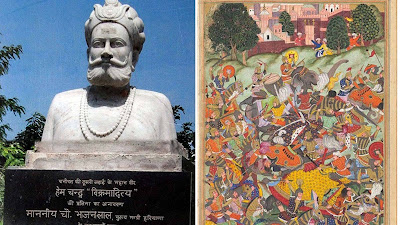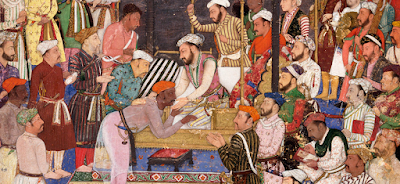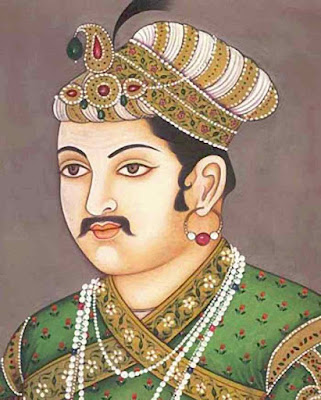 |
| Jagranjosh |
Why was Akbar called 'Akbar the Great'?
Akbar stands tall among the kings who ruled India. He was the greatest of the Mughals. He inherited the throne, after the sudden death of his father, at the age of thirteen, in 1556. Akbar reigned for forty-nine years, and in that period he created a very efficient system of government. He won the hearts of the people by abolishing unfair taxes and improved the system of revenue collection. He also took steps to improve trade and commerce, which made his kingdom stronger and more prosperous.
Akbar was also deeply interested in different religions and welcomed people of all faiths to his religious debates. He was a patron of the arts, and during his reign, painting and architecture reached new heights. He put down many revolts and made his dynasty so secure, that it endured for a hundred years after him. Is it any wonder that he is known as 'Akbar the Great'?
Why did Hemu go to war with Akbar?
 |
| DailyO |
Hemu was a shop keeper in Rewari. By his uncommon ability and commanding power, Hemu had raised himself to the cabinet of Adil Shah, the Afghan musician prince of Chunar. Later, Adil Shah made him his first minister and chief commander.
Ever since Humayun died, Hemu had been planning to attack the Mughals. Hemu never saw defeat in a battle and had romped from victory to victory throughout his life. In 1556, Hemu launched a surprise attack against the Mughals and captured Delhi. He declared himself as the Emperor.
However, Bairam Khan, the guardian of Akbar, insisted on fighting Hemu to win back Delhi. On November 5,1556, the Mughal army met Hemu's army at the historic battlefield of Panipat. In this battle, known as the Second Battle of Panipat, Akbar and Bairam Khan stayed back eight miles away from the battleground. But, Hemu led his large army himself, sitting atop an elephant. Unfortunately, he was wounded in the eye by an arrow and collapsed unconscious. His troops thought he was dead and fled, and thus Hemu's army was defeated. The unconscious Hemu was carried to Akbar's camp, where he has beheaded a tragic end for a brave warrior.
Why was Bairam Khan an important figure during Akbar's reign?
 |
| Bairam Khan's assassination |
Bairam Khan was an extraordinary military general who served Humayun and Akbar. It was Bairam Khan who cleverly concealed the report of Humayun's death to prepare for Akbar's accession to the throne. He then ruled as regent on Akbar's behalf and also acted as a tutor and guide for Akbar.
Bairam was very important during the young ruler's early years in power. Under is care, Akbar consolidated the shaky Mughal kingdom into a vast empire.
However, Bairam became too arrogant and powerful and made the prince a mere puppet. Bairam was dismissed upon Akbar's coming-of-age in 1560. He left for Mecca but was stabbed to death on the way, and died on January 31,1561.
Why was Din-i-Ilahi Akbar's dream?
Akbar dreamt of a religion that would bring together the best principles of all religions. So, he created Din-i-Ilahi, (Divine Faith), which tried to please both Hindus and Muslims.
During the next twenty-four years, Din-i-Ilahi developed as a cult. Many intellectuals like Raja Birbal, Abul Fazl, and Tansen joined the cult. The noticeable feature of this cult was that Akbar was treated as a super-human or semi-divine person, and the whole cult was centered around him. His intention was to create an aura of respect for the throne so that it became a religious duty to obey the emperor. However, Din-i-Ilahi met with a lot of resistance, and eventually, the religion died out.
Which were the major wars fought by Akbar?
Akbar built a vast empire in North India by resorting to wars of conquest, and diplomatic maneuvers. His first and most difficult battle was against the Rajputs of Rajasthan. He knew that unless they were subdued, they would always be a threat to him.
Akbar led his army to the great Rajput fortress of Chitor. This was the capital of Mewar, one of the most important of the Rajput states. Rana Udai Singh, the ruler of Mewar, refused to give in to Akbar's threats, so Akbar surrounded the fort and laid siege to it.

Do you know what a siege is?
lt is the surrounding of a fort or a city by an army in order to force those inside to surrender. No one is allowed to enter or leave so that in time, the people inside will run short of food and starve, or become too weak to fight.
After capturing Chitor, Akbar turned his attention to another Rajput stronghold: the fort of Ranthambhor. It too fell under the might of the Mughal army, and Akbar was now the ruler of the whole of Rajasthan.
How did Akbar conquer the fort at Chitor?
On October 23,1567, Akbar arrived at the outskirts of Chitor and pitched camp. Chitor was the capital of Mewar and was situated on a steep, isolated mass of rock. It was defended by a garrison of 8,000 warriors, supported by 40,000 peasants. Several other Rajput clans and their chiefs were also at the fort during this time. However, Rana Udai Singh had fled to the safety of distant hills.
After a siege of six months, on one night, the Mughals attacked the fort from all sides and created several breaches in the walls. The Rajput warriors put up a stubborn resistance. Finally, Akbar managed to shoot the Rajput leader, Jai Mal. The Rajputs, disheartened by the death of their leader, went back to their homes to gather their wives, children, and property in preparation for the 'Jauhar' or mass suicide.
At dawn on February 23,1568 the Mughal emperor, accompanied by several thousand men, entered the fortress mounted on a majestic elephant. Chitor had fallen, and Akbar emerged triumphant and victorious.
Why did Akbar treat the Rajputs as friends?
Early in his reign, Akbar realized that he could not depend completely on his Muslim officials and followers. Many of them were not wholly loyal to him, even Bairam Khan, his own tutor.
Akbar realized that the Rajputs, who held vast territories, were a people who placed a high value on loyalty and keeping a promise. He decided to seek their friendship so that they would be on his side. So, after defeating the Rajputs, Akbar took them into his service as generals and administrators and took many of their daughters as his wives. He allowed the Rajputs to continue to rule over their own states if they recognized his supremacy and entered into an alliance with him. Akbar's policy of friendship with the Rajput's paid off. The co-operation of Rajputs strengthened the empire. And pi brought great prosperity and cultural vitality too.
Why was Akbar able to rule his empire efficiently?
Akbar the Great was not only a great conqueror, but he was also a great administrator. A military governor was put in charge of each province, who was then responsible for any abuses of power or mistreatments in his area. Akbar also gained the backing off local Hindu provinces through marrying the daughters of various families. in 1563, he abolished the jizya, a tax imposed on most of the non-Muslims. Besides, Akbar did away with a 'pilgrimage' tax paid by Hindus who traveled to various Hindu pilgrimage sites. This ensured him the support of Hindu leaders also. Revenue collection became more efficient, and he was able to encourage farmers to maximize their productivity while increasing the state's revenue. Brilliant administrators managed his finances, and the treasuries had to give a written report of their balance every 15 days.
In short, it was Akbar's vision and understanding of the needs of his people that made him such a great administrator and ruler.
Why is Akbar regarded as the promoter of Mughal art?
Akbar was a great admirer of art and architecture and constructed many palaces and monuments during his reign. The most famous one is the Fatehpur Sikh located at Agra. He also encouraged the distinct tradition of Mughal painting. This is a particular style of miniature paintings depicting scenes from various Hindu epics including the Ramayana and the Mahabharata. Both Muslim and Hindu painters received great encouragement from the emperor. There were also themes with animal fables, individual portraits, and paintings on scores of different subjects. During this period, the Mughal painting reached new heights, thanks to Akbar's patronage.
Why was Birbal so dear to Akbar?
Birbal was one of the most trusted of Akbar's advisors and was one of the 'Nav-Ratna' or nine jewels of the court. His real name was Mahesh Das, and he was a poet and author, who was invited by Akbar to be a part of the royal court, Akbar gave him a new name, Birbal, which means 'strong'.
The wit and wisdom of Birbal had endeared him not only to Akbar, but also to a vast majority of the subjects of the Mughal Empire, Birbal was a good administrator, a valiant soldier, and perhaps what pleased Akbar the most - a humorous jester. There are many stories about Birbal's witty conversations with Akbar. These stories have been handed down from generation to generation, making him without doubt, one of the best-loved figures in the folklore of India.
Why do we say that Akbar was a devoted son?
Akbar's mother, Begum Hamida was only fifteen years older than her son. Akbar loved her dearly and denied her nothing. In fact, he treated her like a goddess. He gave her the title 'Mariam Makhani', which means 'Mary of the Palace'. Mariam or Mary was the mother of Christ, and Akbar compared his own mother to her because he regarded his mother as the epitome of innocence. The title reflected the love and respect he had for his mother.
When Akbar found out that his own son Salim had declared himself King of the Mughals, because he had decided that his father had lived too long, Akbar wanted him executed. But, when Mariam Makhani, the grandmother pleaded for Salim's life, Akbar had no choice but to let him off, for he was a dutiful son. When Mariam Makhani died, Akbar was inconsolable.
Why is Tansen's music regarded as magical?
Tansen, the magical musician, was one of the 'Nav-Ratna' or nine jewels at the court of the Mughal emperor Akbar. He first served as a court musician of the King Ramchandra of Rewa, and then of the emperor Akbar. He was conferred the title of Miyan, by Emperor Akbar, and came to be known as Miyan Tansen since. He is said to have no equals in music, and it is believed that he had performed miracles through his music. In fact, he is supposed to have had the ability to create rain and fire by singing different ragas.
Why is Akbar regarded as a techno-savvy ruler?
Even though Akbar did not know how to read or write, he was very intelligent and fascinated by crafts of all kinds and technical innovations. He used prefabricated structures for his camps and developed new textiles. Even in those days, he studied how to cool buildings, and also how to get cold water during the blazing summers. He was especially interested in developing machinery with gears, and in handguns and cannons. Did you know that he actually invented the wheel that was turned by a bull, so that it could clean the barrels of 16 handguns at one time? Is it any wonder that he was considered to be a techno-savvy ruler?
Why is Fatehpur Sikri so special?
The royal city at Fatehpur Sikri, situated 26 miles west of Agra, was built on the orders of the Mughal emperor Akbar.
Fatehpur Sikri or the 'city of victory was a complex of monuments and temples, all in a uniform architectural style, built-in red sandstone. It includes one of the largest mosques in India, the Jama Masjid. The buildings at Fatehpur Sikri blended both Islamic and Hindu elements in their architectural style. With its elaborate palaces, formal courtyards, reflecting pools, harems, tombs, and a great mosque, it was truly a work of art. Fifteen years later, it was realized that there was a lack of adequate water supply and the city that was meant to be a paradise on earth, was abandoned.





